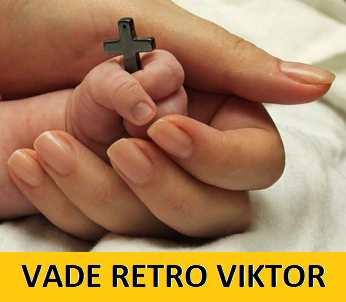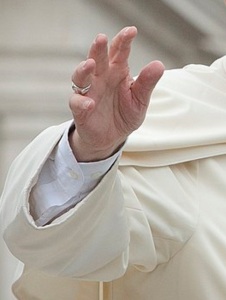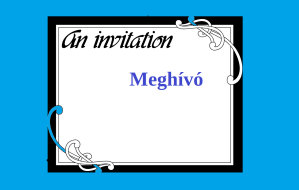⇓ ENGLISH ⇓
⇓ Megosztás ⇓
Ferenc pápa homíliája, 2020. január 1. — Omelie 2020
Solennità di Maria SS.ma Madre di Dio (1° gennaio 2020)[ Arabo – Francese – Inglese – Italiano – Polacco – Portoghese – Spagnolo – Tedesco ]
*
„Amikor eljött az idő teljessége, Isten elküldte Fiát, aki asszonytól született” (Gal 4,4). Asszonytól született: így jött el Jézus. Nem felnőttként jelent meg a világban, hanem, ahogy az evangélium mondta, „méhben fogant” (Lk 2,21): ott tette emberségünket magáévá napról napra, hónapról hónapra.
Egy nő méhében Isten és az emberiség egyesültek, hogy soha többé ne hagyják el egymást: Jézus a mennyben most is abban testben él, amelyet anyja méhében felvett. Istenben ott van a mi emberi testünk!
Az év első napján ezt az Isten és ember közötti nászt ünnepeljük, mely egy nő méhében kezdődött. Emberségünk örökké Istenben lesz, és Mária örökké Isten anyja lesz. Ő nő és anya, ez lényegi fontosságú. Tőle, a nőtől köszöntött ránk az üdvösség, és ezért nincs üdvösség a nő nélkül. Benne Isten egyesült velünk, és ha egyesülni akarunk vele, akkor ugyanazt az utat kell járnunk: Mária, a nő és anya által. Ezért kezdjük az évet a Szűzanyának, annak nőnek a jegyében, aki Isten emberségét szőtte. Ha emberséget akarunk szőni napjaink vetülékeire, a nőtől kell újraindulnunk.
Asszonytól született. Az emberiség újjászületése a nőtől kezdődött. A nők életforrások. Mégis folytonosan bántalmazzák, verik, megerőszakolják őket, arra kényszerítik, hogy prostituálják magukat és elvetessék a méhükben hordozott életet. A nőkkel szembeni minden erőszak Isten megszentségtelenítése, aki asszonytól született. Az üdvösség egy nő testéből érkezett az emberiség számára: emberségünk szintjét azon mérhetjük le, ahogyan egy nő testével bánunk. Hányszor feláldozzuk a nő testét a reklám, a profit, a pornográfia profán oltárán, hányszor kizsákmányoljuk mint használandó látványosságot?! Ki kell szabadítanunk őt a fogyasztás világából, tisztelnünk és becsülnünk kell! A nő teste a legnemesebb test a világon, hiszen megfoganta és világra szülte a Szeretetet, mely üdvösséget hozott nekünk! Ma az anyaság is megaláztatást szenved, mert az egyetlen növekedés, mely érdekel minket, a gazdasági növekedés. Vannak anyák, akik reménytelen, kockázatos utakra adják fejüket, mert kétségbeesetten jobb jövőt szeretnének adni méhük gyümölcsének, de kellő létszámon felülinek ítélik őket olyan emberek, akiknek tele van a hasa, de dolgokkal, szívükbe pedig egy csöppnyi szeretet se szorult.
Asszonytól született. A Biblia elbeszélése szerint a nő a teremtés csúcsát jelenti, mint az egész teremtés összefoglalása. Ő ugyanis az egész teremtés célját magában foglalja: az élet megszülését és őrzését, a közösséget mindennel, a törődést mindennel. Ez az, amit a Szűzanya tesz a mai evangéliumban. „Mária – mondja a szöveg – megőrizte szívében mindezeket a dolgokat, és kereste értelmüket” (Lk 2,19). Mindent megőrzött: az örömet Jézus születéséért és a szomorúságot a Betlehemben megtagadott vendéglátás miatt; József szerelmét és a pásztorok csodálkozását; az ígéreteket és a jövő bizonytalanságát. Mindent a szívébe fogadott, és a szívében minden a helyére került, még a bajok is. Mert mindent szeretettel elrendezett a szívében, és mindent Istenre bízott.
Az evangéliumban Máriának ez a cselekedete másodszor is visszatér: Jézus rejtett életének végén a szöveg ugyanis azt mondja, hogy „anyja mindezeket megőrizte szívében” (Lk 2,51). Ez az ismétlés megérteti velünk, hogy a szívben őrzés nemcsak egy szép gyakorlat, melyet a Szűzanya időről időre megtett, hanem ez szokása volt. A nők sajátja az, hogy szívükbe fogadják az életet. A nők megmutatják, hogy az élet értelme nem dolgok folyamatos előállítása, hanem a meglévő dolgok szívünkbe fogadása.
Csak azok látnak jól, akik szívükkel néznek, mert képesek „belátni”: meglátják a személyt hibái ellenére, a testvért gyengeségein túl, a reményt a nehézségekben, Istent mindenben.
Az új év kezdetekor tegyük fel magunknak a kérdést: „Tudok-e a szívemmel nézni? Tudok-e a szívemmel nézni az emberekre? A szívemben hordozom-e az embereket, akikkel együtt élek, vagy tönkreteszem őket a pletykálkodásommal? És mindenekelőtt: az Úr van-e szívem közepén? Vagy más értékek, más érdekek, az előmenetelem, a vagyon, a hatalom?” Csak akkor tudunk törődni az élettel, és csak akkor tudjuk legyőzni a körülöttünk lévő közömbösséget, ha az életet a szívünkben hordozzuk! Kérjük ezt a kegyelmet: hogy azzal a vággyal éljük meg ezt az évet, hogy másokat a szívünkbe fogadunk, és törődünk másokkal. És ha jobb világot akarunk, olyat, amely a béke otthona, és nem háborús övezet, akkor viseljük szívünkön minden nő méltóságát! A béke fejedelme nőtől született. A nők békét adományoznak és békét közvetítenek, teljesen be kell hát vonni őket a döntéshozatali folyamatokba! Mert amikor a nők továbbadhatják ajándékaikat, a világ egységesebbé és békésebbé válik. Ezért a nők számára elért minden eredmény az egész emberiség számára elért eredmény.
Asszonytól született. Jézus, amint megszületett, visszatükröződött egy nő szemében, anyja arcában. Tőle kapta az első simogatásokat, őrá mosolygott vissza először. Vele indította el a gyengédség forradalmát. Az Egyháznak, a kisded Jézusra nézve, folytatnia kell ezt! Az Egyház is, Máriához hasonlóan, nő és anya! Az Egyház nő és anya, és a Szűzanyában talál rá megkülönböztető vonásaira. Látja őt, a szeplőtelent, és feladatának érzi, hogy nemet mondjon a bűnre és a világiasságra. Látja őt, a termékenyt, és feladatának érzi, hogy hirdesse az Urat, megszülje őt az emberek életében. Látja őt, az anyát, és feladatának érzi, hogy minden embert gyermekeként fogadjon.
Ha az Egyház közeledik Máriához, akkor újra rátalál önmagára, visszatalál középpontjához és egységéhez. Az emberi nem ellensége, az ördög viszont próbálja megosztani, előtérbe helyezni a különbözőségeket, az ideológiákat, az egy-egy oldal által képviselt gondolatokat és a pártokat. De nem értjük az Egyházat, ha a struktúrákból, a programokból, a trendekből, az ideológiákból, a szerepekből kiindulva nézzük: megragadunk belőle valamit, de nem az Egyház szívét. Mert az Egyháznak anyai szíve van. És mi, gyermekei, ma megszólítjuk Isten anyját, aki hívő népként egyesít minket. Ó, anyánk, ébressz reményt bennünk, hozd el nekünk az egységet! Üdvösség asszonya, rád bízzuk ezt az évet, őrizd meg szívedben! Köszöntük téged: Isten szent anyja! Álljunk fel, és mindnyájan együtt köszöntsük a Szűzanyát, mondjuk háromszor: Isten szent anyja! [A hívőkkel közösen:] Isten szent anyja, Isten szent anyja, Isten szent anyja!
Fordította: Tőzsér Endre SP
(Magyar Kurír, 2020. január 1.)
*
HOMILY OF HIS HOLINESS POPE FRANCIS
“But when the time had fully come, God sent forth his Son, born of woman” (Gal 4:4). Born of woman: Jesus came in this way. He did not appear in the world as an adult but, as the Gospel tells us, he was “conceived in the womb” (Lk 2;21). It was there that he made our humanity his own: day after day, month after month. In the womb of a woman, God and mankind are united, never to be separated again. Even now, in heaven, Jesus lives in the flesh that he took in his mother’s womb. In God, there is our human flesh!
On the first day of the year, we celebrate this nuptial union between God and mankind, inaugurated in the womb of a woman. In God, there will forever be our humanity and Mary will forever be the Mother of God. She is both woman and mother: this is what is essential. From her, a woman, salvation came forth and thus there is no salvation without a woman. In her, God was united to us, and if we want to unite ourselves to him, we must take the same path: through Mary, woman and mother. That is why we begin the year by celebrating Our Lady, the woman who wove the humanity of God. If we want to weave humanity into this our time, we need to start again from the woman.
Born of woman. The rebirth of humanity began from a woman. Women are sources of life. Yet they are continually insulted, beaten, raped, forced to prostitute themselves and to suppress the life they bear in the womb. Every form of violence inflicted upon a woman is a blasphemy against God, who was born of a woman. Humanity’s salvation came forth from the body of a woman: we can understand our degree of humanity by how we treat a woman’s body. How often are women’s bodies sacrificed on the profane altars of advertising, of profiteering, of pornography, exploited like a canvas to be used. Yet women’s bodies must be freed from consumerism; they must be respected and honoured. Theirs is the most noble flesh in the world, for it conceived and brought to light the love that has saved us! In our day, too, motherhood is demeaned, because the only growth that interests us is economic growth. There are mothers who risk difficult journeys desperately seeking to give a better future to the fruit of their womb, yet are deemed redundant by people with full stomachs but hearts empty of love.
Born of woman. The Bible tells us that woman come onto the scene at the height of creation, as a summation of the entire created world. For she holds within herself the very purpose of creation: the generation and safekeeping of life, communion with all things, care for all things. So it is with the Mother of God in today’s Gospel. The text tells us, “But Mary kept all these things, pondering them in her heart” (v. 19). She kept all these things: joy at the birth of Jesus and sadness for the lack of hospitality shown in Bethlehem; the love of Joseph and the amazement of the shepherds; the promise and the uncertainty of the future. She took everything to heart, and in her heart, she put everything in its right place, even hardships and troubles. In her heart, she lovingly set all things in order and entrusted everything to God.
In the Gospel, Mary does this a second time: at the end of the hidden life of Jesus, we are told that “his mother kept all these things in her heart” (v. 51). This repetition makes us realize that “keeping in her heart” was not something nice that Our Lady did from time to time, but something habitual. Women typically take life to heart. Women show us that the meaning of life is not found in making things but in taking things to heart. Only those who see with the heart see things properly, because they know how to “look into” each person: to see a brother apart from his mistakes, a sister apart from her failings, hope amid difficulty. They see God in all persons and things.
As we begin this new year, let us ask ourselves: Do I know how to see with the heart? Do I know how to look at people with the heart? Do I take to heart the people with whom I live? Or do I tear them down by gossip? And above all, do I put the Lord at the centre of my heart, or other values, other interests, like advancement, riches, power? Only if we take life to heart will we know how to take care and overcome the indifference all around. So let us ask for the grace to live this year with the desire to take others to heart and to care for them. And if we want a better world, a world that will be a peaceful home and not a war field, may we take to heart the dignity of each woman. From a woman was born the Prince of peace. Women are givers and mediators of peace and should be fully included in decision-making processes. Because when women can share their gifts, the world finds itself more united, more peaceful. Hence, every step forward for women is a step forward for humanity as a whole.
Born of woman. Jesus, newly born, was mirrored in the eyes of the woman, in the face of his mother. From her, he received his first caresses; with her, he exchanged the first smiles. With her began the revolution of tenderness. The Church, looking at the Baby Jesus, is called to continue that revolution. For she too, like Mary, is both woman and mother. The Church is woman and mother, and in Our Lady, she finds her distinctive traits. She sees Mary immaculate, and feels called to say no to sin and to worldliness. She sees Mary fruitful, and feels called to proclaim the Gospel and to give birth to it in people’s lives. She sees Mary a mother, and she feels called to receive every man and woman as a son or daughter.
In drawing close to Mary, the Church discovers herself, she finds her centre and her unity. The enemy of our human nature, the devil, seeks instead to divide, to highlight differences, ideologies, partisan thinking and parties. But we do not understand the Church if we regard her by starting with structures, programmes and trends, ideologies and functions. We may grasp something, but not the heart of the Church. Because the Church has a mother’s heart. And we, as her sons and daughters, invoke today the Mother of God, who gathers us together as a people of believers. O Mother, give birth to hope within us and bring us unity. Woman of salvation, to you we entrust this year. Keep it in your heart. We acclaim you, the Holy Mother of God. All together now, for three times, let us stand and acclaim the Lady, the Holy Mother of God. [with the assembly] Holy Mother of God, Holy Mother of God, Holy Mother of God!
(Vatican Basilica, Wednesday, 1st January 2020)
*

Üdvözlettel: Szigeti Boglárka
Kapcsolódó aloldalak:
Keresztre feszített nők (2019.)
****************************************










Hozzászólás